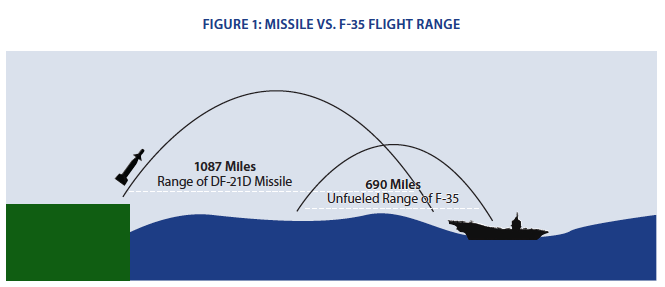The cover illustration on a new report questioning the Navy's carrier strategy.
Navy gospel — as well as U.S. naval fleets and strategy — are built around $15 billion aircraft carriers, outfitted with dozens of $150 million airplanes.
Only one thing worse than someone criticizing the backbone of the Navy fleet, is having a Navy officer do it – especially a career naval flight officer who has spent much of his career on such behemoths.
Yet that is just what Captain Henry Hendrix has done in a new report – At What Cost a Carrier — for the independent Center for a New American Security, here.
Hendrix argues that the aircraft carrier — the centerpiece of American naval operations for more than 70 years – could become too vulnerable to be relevant in future wars. He suggests that a smarter approach might be a greater use of drones as well as submarines outfitted with long-range missiles.
“The aircraft carrier is in danger of becoming like the battleships it was originally designed to support: big, expensive, vulnerable – and surprisingly irrelevant to the conficts of the time,” Hendrix writes. “This outcome has become more likely as the Navy continues to emphasize manned carrier aircraft at the expense of unmanned missiles and aircraft.”
Defense experts been saying similar things for years. “We should scale back our carrier design to something much cheaper and simpler,” Thomas P.M. Barnett, a former Pentagon deep thinker and chief strategist at Wikistrat, a geopolitical-analysis firm, told Time two years ago, here. “Think of mother ships launching waves of cheap drones — that would actually be more frightening and intimidating.”
The Navy remains unswayed. “As any reader of Proceedings could readily attest, the Navy encourages our officers to think, write and debate issues of import to national security,” says Rear Admiral John Kirby, the Navy’s chief of information. “Captain Hendrix clearly has done that in this expression of his personal views. The Navy remains committed to its carrier fleet, to the warfighting edge provided by naval aviation, and to improving both as we move forward.”
Hendrix’s report is the first in a new series of aptly-titled “Disruptive Defense Papers” published by CNAS, designed to illuminate coming hard choices facing the U.S. military.



